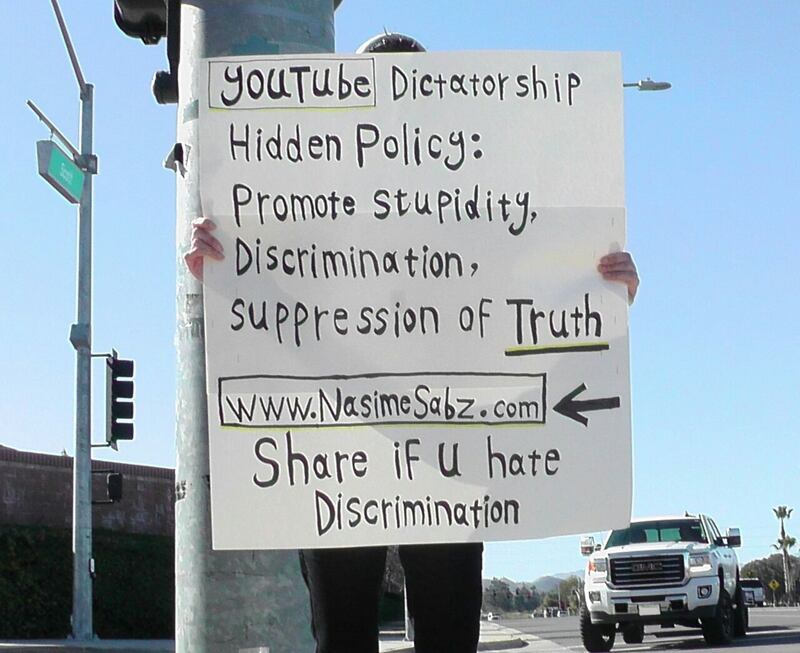MENIFEE, California—The woman who shot three people before killing herself at YouTube’s headquarters on Tuesday said the video-sharing site was “censoring” her vegan activism.
Nasim Aghdam, 39, was a prolific YouTuber and and longtime vegan activist. Her now-deleted videos included music video parodies, bodybuilding videos, and videos on vegan activism. She had been a vocal vegan activist since at least 2009, attending multiple demonstrations with PETA. But Aghdam grew angry at YouTube over the past year, accusing it of cutting off her viewership and revenue, and implying the company was trying to censor her vegan videos.
“The parents warned police be careful, she’s angry at YouTube,” one of Aghdam’s family members in Menifee, California, told The Daily Beast on Wednesday. “Because she has this anger for one year. They filtered her videos.”
“I’m sorry, I can’t believe it,” her father told reporters outside his home in Menifee on Wednesday afternoon.
Prior to her YouTube career, Aghdam attended animal rights rallies, including a 2009 PETA demonstration against the Marine Corps’ use of live pigs in medical treatment exercises.
“For me, animal rights equal human rights,” Aghdam, who wore pants spattered with fake blood, told the San Diego Union-Tribune at the time.
PETA said it has hasn’t seen Aghdam in nearly a decade.
“She appeared at a few demonstrations about nine years ago, but the phone number she gave did not work, and she did not contact us after that,” the organization told The Daily Beast in a statement. “We have not been in contact with her.”
Aghdam posted a series of pictures from animal rights protests to her Telegram account showing her attending demonstrations in the San Diego area. The Telegram account was linked on her personal website.
One picture posted in February 2017 appears to show Aghdam attending a November 2010 demonstration of a Society for Neuroscience conference at the San Diego Convention Center holding a sign depicting a monkey with the words “Why Me?” written on it.

Protesters told the San Diego Union-Tribune at the time that they were trying to “open a dialogue” with neurologists about the role of primate experiments in neurological research.
A spokesperson for Stop Animal Exploitation Now, one of the groups organizing the protest, said Aghdam was not affiliated with it and noted that protests are widely advertised in local media, allowing anyone to attend. “Before the news media coverage, we had never even seen the name before, so she’s not connected to us in any way,” the spokesperson said.
Another picture from Aghdam’s Telegram account shows her attending a protest of KFC, holding a PETA sign with the words “Scalded Alive” while standing beside two women painted red sitting in a tub that reads “KFC Scalds Chicks to Death.”

But Aghdam appears to have viewed a new YouTube policy as a barrier to her activism.
Around the beginning of 2017, she started making videos and pictures railing against the website. On Telegram, she shared a picture of herself standing by a highway holding a poster accusing YouTube of suppressing her channel.
“YouTube Dictatorship,” the poster read. “Hidden Policy: Promote Stupidity, Discrimination, Suppression of Truth… Share if u hate Discrimination.”

On her personal website, Aghdam called YouTube a “dictatorship” and accused it of “filter[ing] my channels to keep them from getting views!”
Aghdam appeared to have been referencing “demonetization,” a process through which YouTube flags videos as ineligible to receive advertising money.
If Aghdam’s videos were demonetized, she was far from alone. Over the past two years, YouTube has cut back on ad revenue for a number of smaller channels. Some communities, like LGBT vloggers, have complained that their videos were disproportionately flagged to be demonetized. Other YouTubers noted that the website appeared to be using an algorithm that automatically flagged whole genres of videos, like “unboxing” videos in which vloggers filmed themselves testing out new phones.
Some vegan YouTubers claimed the site had been specifically cracking down on their videos. In one well-circulated video, a prominent vegan vlogger said YouTube had flagged her video as unsuitable for children, likely due to its graphic content. Aghdam later shared that YouTuber’s video on her own site, alongside screenshots purportedly showing how Aghdam’s viewership and ad revenue had fallen.
Family members confirmed that Aghdam had been angry at the drop in viewership. Her father told the East Bay Times that she “hated” the company. Her brother told the paper that Aghdam “was always complaining that YouTube ruined her life,” and family members told KQED that she and her mother were always arguing over her YouTube obsession.
Aghdam and family members had a fight in recent days, her parents told police. Last week she disappeared from her home in Menifee, California, apparently headed for YouTube’s headquarters. Her family told police and reported her missing on March 31. Police spotted her sleeping in her car near the YouTube headquarters early Tuesday night but said she did not appear to pose a threat when questioned.
“At no point during our roughly 20-minute interaction with her did she mention anything about YouTube, if she was upset with them, or that she had planned to harm herself or others,” police said in a statement. “Throughout our entire interaction with her, she was calm and cooperative.”
Police called Aghdam’s family, who described a recent family dispute.
“The father confirmed to us that the family had been having issues at home,” police said. About an hour after that call, her father called back “to let us know that she made a series of vegan videos for her channel on YouTube and that the company had recently done something to her videos that had caused her to become upset. Aghdam’s father stated that she may have been in the area because of this.”
But what Aghdam claimed was an attempt to censor her videos, particularly those about veganism, may just have been the work of YouTube’s new standards for monetization. Earlier this year, the company announced that it would not monetize any channels with fewer than 4,000 hours of watch time over the past 12 months.
After Aghdam shot up YouTube’s headquarters, the company deleted Aghdam’s multiple accounts “due to multiple or severe violations of YouTube’s policy against spam, deceptive practices and misleading content or other Terms of Service violations.”
In Menifee, a rural town 80 miles southeast of Los Angeles in Riverside County, a dozen investigators including ATF agents arrived at the Aghdam family home on Wednesday.
Nasim Aghdam moved here with her family a year ago from San Diego, neighbors told The Daily Beast. Aghdam immigrated to the United States as a refugee from Iran when she was 18, according to a relative who spoke with reporters in front of the family home.
Neighbors expressed disbelief at the news of Aghdam’s shooting at the YouTube campus in faraway San Bruno. One neighbor who said he painted the exterior of the house around the time the family moved in said he saw her a few times and recalled her as friendly and that nothing seemed out of the ordinary.
A sheriff’s deputy standing sentry at the front of the house said that at least some of the agents had come from San Bruno and were executing a search warrant at the house.
At 2 p.m., law enforcement investigators left the house and departed in a three-car convoy led by a sheriff’s escort.
—with additional reporting by Jason McGahan in Menifee, California







